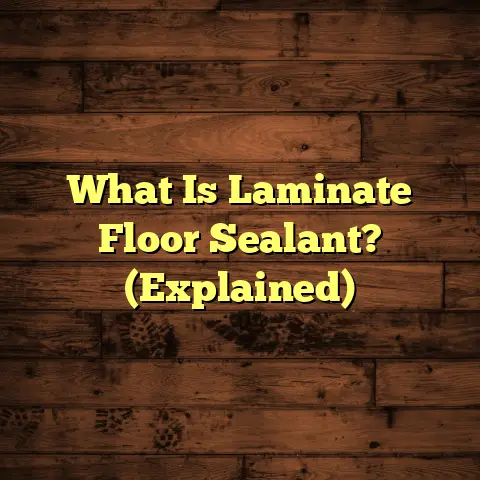Castile Soap as Floor Cleaner? (Don’t Do This!)
I’ve been hearing a lot about folks using Castile soap to clean their floors.
It’s natural, it’s eco-friendly, and it seems like the perfect solution, right?
Well, hold on a sec.
While I love the idea of natural
cleaning products, I’ve got some serious reservations about
using Castile soap on floors.
You know, the whole au naturel cleaning thing is super
trendy right now.
I see influencers on Instagram raving about
it, eco-blogs singing its praises, and even my own neighbors
swearing by it.
They talk about how it’s plant-based, biodegradable, and
safe for the environment.
And honestly, I get the appeal.
Who wouldn’t want a simple, minimalist cleaning routine that’s
good for the planet?
But here’s the thing: just because
something is natural doesn’t automatically make it the best
choice for your floors.
Trust me; I’ve seen the aftermath.
So, let’s dive in and
find out why Castile soap might not be the floor-cleaning
miracle you’ve been hoping for.
Section 1: Understanding Castile Soap
So, what exactly is Castile soap?
It’s not some newfangled
invention; it’s been around for centuries!
Historical Context
Castile soap originated in the Castile region of Spain, where it was traditionally made with olive oil.
Think of it as the OG of natural soaps!
Over time, the
recipe has evolved, and now you can find Castile soap made
with other vegetable oils like coconut, palm, or hemp.
But the basic idea is the same: it’s a simple, plant-based soap with no harsh chemicals or synthetic ingredients.
Types of Castile Soap
You’ll typically find Castile soap in two forms: liquid and bar.
Liquid Castile soap is super versatile and can be used for
everything from washing your face to doing laundry.
Bar Castile soap is great for handwashing and showering.
You’ll also find different variations, like scented and
unscented, organic and conventional.
The scented versions usually get their fragrance from essential oils, which is a nice touch.
Benefits of Castile Soap
Okay, so what’s the big deal about Castile soap?
Well, it has
some pretty impressive cleaning properties.
It’s a natural
degreaser, it’s gentle on the skin, and it’s biodegradable.
Plus, it’s a great option for people who are trying to avoid toxic chemicals in their cleaning products.
I get it; it sounds amazing!
But before you go pouring it all
over your floors, let’s talk about why it might not be the
best idea.
Section 2: The Popularity of Natural Cleaning Products
Why are so many people ditching conventional cleaners and
going natural?
I think there are a few key reasons.
Health and Environmental Concerns
For starters, there’s a growing awareness of the harmful
chemicals in conventional cleaners.
People are worried about
the impact these chemicals have on their health and the
environment.
I mean, who wants to breathe in fumes that can irritate your lungs or expose your family to toxins?
According to the EPA, many common household cleaners contain
volatile organic compounds (VOCs), which can contribute to
indoor air pollution.
EPA VOCs
Branding and Marketing
Brands have definitely caught on to this trend and are marketing natural cleaning products like Castile soap as safe and effective alternatives.
They highlight the plant-based ingredients, the lack of harsh chemicals, and the eco-friendly packaging.
It’s smart marketing because it taps into people’s desire to make healthier and more sustainable choices.
Consumer Behavior
I think there’s also a psychological factor at play here.
People are craving authenticity, transparency, and simplicity
in their lives.
Natural cleaning products fit into that narrative.
They feel
less processed, more wholesome, and more connected to nature.
It’s like, by choosing a natural cleaner, you’re not just cleaning your house; you’re also making a statement about your values.
Section 3: The Downsides of Using Castile Soap on Floors
Alright, here’s the part you’ve been waiting for: why Castile soap can be a real pain in the you-know-what when it comes to floor cleaning.
This is where I put on my expert flooring contractor hat and tell you what I’ve seen go wrong over the years.
Residue and Build-Up
The biggest problem with using Castile soap on floors is that it can leave a residue or film behind.
This happens because Castile soap is, well, soap!
It reacts
with minerals in hard water to form soap scum.
And that scum can build up on your floors over time, making them look dull, cloudy, and even slippery.
I’ve seen floors that were once shiny and beautiful become
covered in a sticky, grimy film after repeated use of Castile
soap.
It’s not pretty, folks.
pH Imbalance
Castile soap has a relatively high pH level (around 9-10), which can be problematic for certain types of flooring.
For example, wood floors are naturally acidic, and using a high-pH cleaner like Castile soap can disrupt their natural balance.
This can lead to the finish breaking down, the wood drying out, and even warping or cracking.
Tile and grout can also be affected by pH imbalances.
The
alkaline nature of Castile soap can dissolve grout over time,
making it more susceptible to staining and damage.
Ineffectiveness Against Tough Stains
While Castile soap is a decent cleaner for everyday dirt and grime, it’s not the best choice for tackling tough stains.
I’m talking about things like grease, oil, red wine, or pet
accidents.
These types of stains often require specialized
cleaning products that are specifically formulated to break
them down.
Castile soap might lighten the stain a bit, but it’s unlikely
to remove it completely.
And if you scrub too hard, you could
end up damaging your floor.
Compatibility Issues
Not all flooring types are created equal, and Castile soap is definitely not compatible with all of them.
For example, I would never recommend using Castile soap on
unfinished wood floors.
The soap can soak into the wood and
cause it to swell, stain, or even rot.
Laminate floors can also be tricky.
While some laminate floors
can tolerate Castile soap, others can be damaged by the
excess moisture.
And if you have waxed floors, Castile soap can strip away the wax finish, leaving your floors looking dull and unprotected.
Dilution and Application Challenges
Even if your flooring is compatible with Castile soap, getting the dilution ratio and application method just right can be a challenge.
Too much soap, and you’ll end up with a sticky residue.
Not
enough soap, and your floors won’t get clean.
And if you don’t rinse your floors thoroughly after washing them with Castile soap, you’re just asking for trouble.
I’ve seen people struggle to find the right balance, and it can be frustrating to experiment and try to figure it out.
Section 4: Real-Life Examples and Testimonials
Okay, let’s get real.
I want to share some stories from people
who have actually used Castile soap to clean their floors.
Success Stories
I don’t want to paint a completely negative picture here.
There are some people who have had positive experiences using
Castile soap on their floors.
They often say that they were drawn to Castile soap because it’s natural, gentle, and doesn’t have a strong chemical smell.
Some people with tile floors have found that Castile soap works well for them, especially if they have soft water.
And I’ve heard from a few folks with sealed hardwood floors who have had success using Castile soap in very diluted form.
But even in these success stories, people often emphasize the importance of using the right dilution ratio and rinsing thoroughly.
Cautionary Tales
Now, let’s talk about the horror stories.
These are the
accounts that really make me cringe.
I’ve heard from people who used Castile soap on their wood floors and ended up with a dull, sticky film that they couldn’t get rid of.
They tried everything – scrubbing, mopping, even renting a floor buffer – but nothing worked.
Eventually, they had to hire a professional to strip and reseal their floors, which cost them a pretty penny.
I’ve also heard from people who used Castile soap on their laminate floors and ended up with bubbling, warping, and peeling.
The excess moisture from the soap seeped into the seams of the laminate and caused irreversible damage.
And then there are the stories of people who used Castile soap on their tile floors and ended up with a grimy build-up in their grout lines.
They scrubbed and scrubbed, but the grime just wouldn’t budge.
Eventually, they had to resort to using harsh chemicals to
clean their grout, which defeated the whole purpose of using a
natural cleaner in the first place.
Expert Opinions
I’m not the only one who’s skeptical about using Castile soap
on floors.
I’ve talked to other cleaning professionals and
flooring experts who share my concerns.
They often advise against using Castile soap on floors, especially on delicate surfaces like wood or laminate.
They point out the risks of residue build-up, pH imbalance, and compatibility issues.
And they emphasize that there are plenty of other natural cleaning products that are specifically formulated for floors and are less likely to cause damage.
I mean, I’m all for natural cleaning, but I also believe in
using the right tool for the job.
And in many cases, Castile
soap just isn’t the right tool for cleaning floors.
Section 5: Conclusion
Okay, we’ve covered a lot of ground here.
Let’s recap the key
points and wrap things up.
I started this article by talking about the rising trend of
using Castile soap as a floor cleaner.
I acknowledged the
appeal of natural cleaning products and the desire for a
simple, sustainable cleaning routine.
But I also pointed out that Castile soap isn’t always the best
choice for floors.
It can leave a residue, disrupt the pH
balance, and damage certain types of flooring.
I shared real-life examples of people who have had both positive and negative experiences using Castile soap on their floors.
And I emphasized that cleaning professionals and flooring experts often advise against using Castile soap on floors due to the potential risks.
Call to Action
So, what’s the takeaway here?
Well, I want to encourage you to
think critically about your cleaning choices.
Don’t just blindly follow trends or assume that natural products are always the best option.
Consider the specific needs of your flooring and choose cleaning products that are specifically formulated for those needs.
Read the labels carefully, follow the instructions, and test the product in an inconspicuous area before applying it to the entire floor.
And if you’re unsure about anything, don’t hesitate to consult with a cleaning professional or flooring expert.
Final Thoughts
Ultimately, maintaining your home is about making informed
decisions.
It’s about understanding the potential consequences
of your choices and choosing products that will protect your
investment.
I know it can be tempting to jump on the bandwagon and try the
latest cleaning fad.
But when it comes to your floors, it’s
always better to err on the side of caution.
So, the next time you’re tempted to reach for that bottle of
Castile soap, remember what I’ve told you today.
Think about
the risks, consider your flooring type, and make a choice that
you can feel confident about.
Your floors will thank you for it!





